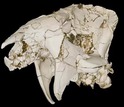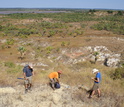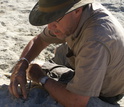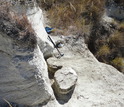News Release 14-145
Scientists discover fossil of bizarre groundhog-like mammal on Madagascar
Newly discovered fossil alters thinking on evolution of early mammals
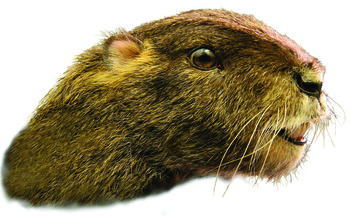
Artist's reconstruction of the huge groundhog-like animal that once lived on Madagascar.
November 5, 2014
This material is available primarily for archival purposes. Telephone numbers or other contact information may be out of date; please see current contact information at media contacts.
Paleontologists have discovered an almost complete skull of a previously unknown mammal that likely resembled a large modern-day groundhog and lived alongside dinosaurs.
The species, found on Madagascar, is shaking up theories of early mammal evolution and diversity.
Stony Brook University paleontologist David Krause led the research team, which reports its findings in today's issue of the journal Nature.
The new fossil mammal is named Vintana sertichi.
Vintana belongs to a group of early mammals called gondwanatherians, which had been known only from a few teeth and jaw fragments.
Because of this fragmentary understanding, the mammals' evolutionary placement hadn't been clear. The well-preserved skull of Vintana sertichi is giving researchers their first clear insights into the life habits and relationships of gondwanatherians.
"We know next to nothing about early mammalian evolution on the southern continents," says Krause. "This discovery underscores how little we really know. No paleontologist could have come close to predicting the odd mix of features this cranium exhibits."
The skull measures almost five inches long, twice the size of the largest known mammal skull from the Age of Dinosaurs in the Southern Hemisphere.
At a time when the majority of mammals were shrew- or mouse-sized--mere shadows of dinosaurs--Vintana was a super heavyweight, estimated to have had a body mass of about 20 pounds, two or three times the size of an adult groundhog today.
Vintana's skull has an unusual shape, with deep, huge eye sockets, and long, scimitar-shaped flanges for attachment of massive chewing muscles.
"This is the first discovery of a cranial fossil from the extinct group of mammals called Gondwanatheria in the Southern Hemisphere," says Yusheng (Chris) Liu, program director in the National Science Foundation's (NSF) Division of Earth Sciences, which funded the research along with the National Geographic Society.
"The finding will help us better understand the early evolution of this mammal group," says Liu.
The initial discovery came about by chance, says Krause.
Vintana means luck and refers to the good fortune its discoverer, researcher Joe Sertich, then of Stony Brook University, had in finding the fossil.
Sertich collected a 150-block rock matrix filled with fish fossils. When the block was CT-scanned at Stony Brook, the images revealed something rare inside--a nearly complete skull of a previously unknown ancient mammal.
"When we realized what was staring back at us on the computer screen, we were stunned," says scientist Joe Groenke of Stony Brook, the first to view the CT images.
Groenke spent the next six months extracting the skull from the surrounding rock matrix, one sand grain at a time.
Krause and colleagues conducted a comprehensive analysis of the skull, much of it using micro-computed tomography and scanning electron microscopy to reveal minute aspects of its anatomy.
They compared the skull to those of hundreds of other fossil and extant mammals.
Its teeth, eye sockets, braincase, and inner ear revealed that Vintana was likely a large-eyed herbivore that was agile, with keen senses of hearing and smell.
These and other features were also used to analyze its relationships to other early mammals.
Vintana and other gondwanatherians were probably close relatives of multituberculates, the most successful mammalian contemporaries of dinosaurs on Northern Hemisphere continents.
Krause says that a major question remains for scientists: How did such an unusual creature evolve?
Madagascar was an island for more than 20 million years before the time in which the rock strata containing Vintana were deposited.
Krause theorizes that the primitive features of the skull are holdovers from a time when an ancient lineage that ultimately produced Vintana was marooned on the island.
It was this isolation, he believes, first from Africa, then Antarctica/Australia, and finally the Indian subcontinent that allowed the evolution of Vintana's unique and bizarre features.
-NSF-
-
View Video
NSF-funded paleontologists discover fossil of groundhog-like mammal on Madagascar.
Credit and Larger Version -
The skull of the newly discovered mammal Vintana sertichi at an early stage of excavation.
Credit and Larger Version -
Scientists near the Madagascar site where Vintana sertichi's skull was found.
Credit and Larger Version -
Paleontologist David Krause excavating fossils from sediments in Madagascar.
Credit and Larger Version -
Scientist Joseph J.W. Sertich, a member of the team, conducting field work in Madagascar.
Credit and Larger Version -
The sediment block in which the skull of Vintana sertichi was later seen on CT scans.
Credit and Larger Version
Media Contacts
Cheryl Dybas, NSF, (703) 292-7734, email: cdybas@nsf.gov
Greg Filiano, Stony Brook University, (631) 444-9343, email: gregory.filiano@stonybrookmedicine.edu
Related Websites
NSF News: Scientists Discover "Giant Fossil Frog from Hell": http://www.nsf.gov/news/news_summ.jsp?cntn_id=111119
NSF Grant: Cretaceous Vertebrates from Madagascar: A Window into the Biogeographic and Plate Tectonic History of Gondwana: http://www.nsf.gov/awardsearch/showAward?AWD_ID=1123642&HistoricalAwards=false
The U.S. National Science Foundation propels the nation forward by advancing fundamental research in all fields of science and engineering. NSF supports research and people by providing facilities, instruments and funding to support their ingenuity and sustain the U.S. as a global leader in research and innovation. With a fiscal year 2023 budget of $9.5 billion, NSF funds reach all 50 states through grants to nearly 2,000 colleges, universities and institutions. Each year, NSF receives more than 40,000 competitive proposals and makes about 11,000 new awards. Those awards include support for cooperative research with industry, Arctic and Antarctic research and operations, and U.S. participation in international scientific efforts.
Connect with us online
NSF website: nsf.gov
NSF News: nsf.gov/news
For News Media: nsf.gov/news/newsroom
Statistics: nsf.gov/statistics/
Awards database: nsf.gov/awardsearch/
Follow us on social
Twitter: twitter.com/NSF
Facebook: facebook.com/US.NSF
Instagram: instagram.com/nsfgov

